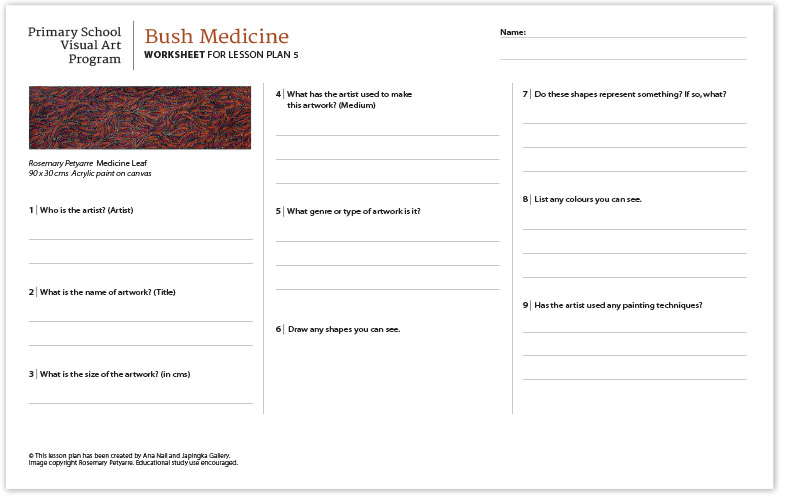

Activity 5
Response to Bush Medicine artworks
This activity provides an opportunity for students to consider and respond to an artist’s artwork, to build their knowledge but also consider an artist’s viewpoint and how they communicate this through visual conventions.
Curriculum content descriptions
Western Australian Curriculum
Responses to their own and others’ artworks reflecting on the use of artistic elements, using visual arts terminology.
Responses that involve identifying the meaning of artworks from various cultures.
Australian Curriculum Version 8 Content Descriptions
Identify intended purposes and meanings of artworks, using visual arts terminology to compare artworks, starting with visual artworks in Australia including visual artworks of Aboriginal and Torres Strait Islander Peoples (ACAVAR113).
Materials
Worksheet for Lesson Plan 5.
Images of Rosemary Petyarre Medicine Leaf.
Pencils, textas.

Activity
Recap previous activities, focusing discussion on the intention of representing bush leaves and the bush floor.
Discuss the different techniques, tools and materials used to create the papers intended for use in the students' collage activity.
Discuss how artists have portrayed their own natural environment for tens of thousands of years e.g., Kimberley rock art.
Discuss with students. What messages could they wish to share with others?
Display image of Rosemary Petyarre Medicine Leaf.
Allow silent time for students to view the image. Ask students to be aware of their first impressions. What captures your attention? What does this work remind you of?
Display Worksheet for Lesson Plan 5.
Discuss questions 1 to 5, seek information about the artwork. Explain/remind students that information about the artwork is under the image on the worksheet. In an art gallery, it may be on a label next to the artwork on a wall. In a book, it is usually on the same page as the artwork. Students to complete questions 1 to 5.
Discuss with students questions 6 and 7. Question 6 asks students to draw shapes used in the artworks while question 7 asks students to consider what these shapes could represent.
Students complete questions 6 and 7.
Question 8 asks students to list the colours they can see in the artwork. Question 9 asks students to suggest the painting techniques that the artist may have used. In previous activities students were involved in using a variety of painting techniques and may draw from this experience, or suggest other techniques such as using “dots”.
Students complete questions 8 and 9.
Ask the question, why you think the artist has created this artwork?
The following are some examples of Year 3 student responses to that question.
“To explain different types of bush medicine that you use for different things and they celebrate it.”
“So people can see what medicine they used because there was no doctors or hospitals there so they had to use plants in Utopia.”
“Because he/she treasures the leaves because they are used for medicine.”
“Because Aboriginals really care about the bush medicine and want people to respect the leaves. The artist also collects the leaves.”
“So people understand how important Aboriginal culture and plants are important.”
“To share a story to the world.”
Teacher Notes
For written tasks, support weaker literacy students by scribing their oral response.
Time
For this documented project, Year 3 students required one 50 minute lesson for Q 1 – 5 and a further 50- minutes for Q 6 – 9.
© This lesson plan has been created by Ana Nail and Japingka Gallery. Educational study use encouraged.
Overview | Lesson 1 | Lesson 2 | Lesson 3 | Lesson 4 | Lesson 5 | Lesson 6 | Lesson 7 | Lesson 8 | Lesson 9 | Lesson 10 | Lesson 11
